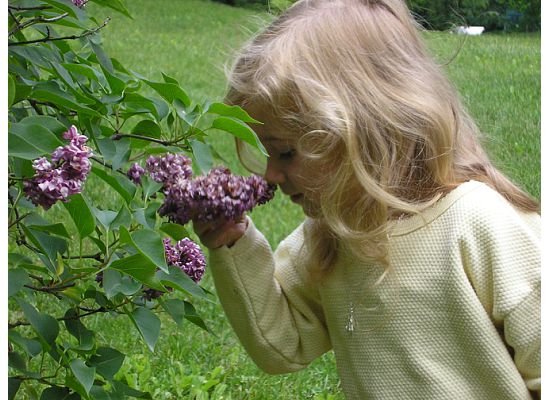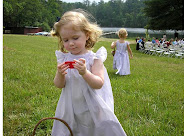
There's a demon I can’t shake: red, orange, green and white Victorian house in Adams, Massachusetts.
Yes, it’s just a house, but this is no ordinary house: it was my first love. And I'm sorry, one really never forgets that first love. Six years ago, about to relocate to the Berkshires from New York City, my husband- to-be and I started house-hunting. He had just accepted an offer to teach at Williams College, so we started looking at houses in Williamstown, naturally. Everything in our price range was either seedy, needed great amounts of renovation and repair, or was in a location that just wouldn’t work for us (like on a main road).
We branched out into other, neighboring communities, and saw a rambling old blue Victorian on Church Street in North Adams, a town known for its rambling old Victorians. I loved the tin ceilings, the historical marker by the front door, the back staircase. But this one had been a two family home and it needed more vision than we could provide.
We ventured further south, to North Adams’ little sister, also curiously known as The Mother Town, Adams. Up Orchard Street, left on East Street, and there it was: the stately Victorian manse of my dreams. It wasn't red and white then, just a dusty, peeling grayish gray. Spindles and porches and a wreath on the double wood door, crenulations and detailed decorations abounded. It was tall, dark and so handsome. Something about it made me want to snap my fingers and sing, "The Addams Family" theme song. Sure, it needed a paint job on the outside, and it appeared that the garage/barn was on its last legs, but my heart raced. This is my house, I thought. We were made for each other.
With my heart in my throat, we entered the back door with the realtor. The kitchen made me gasp: it was as if we had entered the set of a 1950s movie. What was this kitchen doing in a nineteenth-century Victorian? Didn’t matter. The appliances were old, but they were top quality. In its day, it was a very fancy kitchen, for sure. I could be Mrs. Cleaver and bake cookies here. I loved it. I loved the back staircase, even though loose boards creaked, I loved the breakfast nook that had a view of Mount Greylock. I loved the small den, even if a floor-to-ceiling crack threatened to open and swallow everything inside, I loved the living/dining room, with the curved window looking out onto another Victorian home, this one many different shades of pink and cream. I especially loved the front entryway. We rang the doorbell, and I was deeper in love. Giddy. Not only did it sound like the ringing from some black and white horror movie, but there were actual bells in the foyer that binged and bonged when the doorbell was pushed. This was not a rinky-dink doorbell. This doorbell meant business. A small hearth in the entry way was lined with blue tiles. A hearth. I played with the word in my mouth.
The dark wood staircase wound its way upstairs, a stained-glass window at the landing. Upstairs there was much to love, four bedrooms, one with a balcony: my study, I’ll write my dissertation in this room, and go out onto the balcony for fresh air, I thought. Two bathrooms in the back, one curiously cloaked in Bakelite fixtures. I pictured bathing our as-yet-unborn children in the large tub in the ‘kid’s bathroom.’ The sun-room that had views to the top of Greylock, our as-yet-unborn childrens’ playroom. There was more: a third floor aerie that would be perfect as an exercise room, and a small bedroom – another guest room or children’s hideaway.
The basement held more treasures: a soapstone sink, a root cellar, and many creepy nooks and crannies hidden away, the musty dirt floor keeping me from getting too curious. I didn't care. This was my house. Make an offer, the realtor suggested, the owners (a young couple with two or three kids) want to sell. I was too excited to sleep. I dreamt of the house, what if someone else fell in love with it? It was like that feeling after a first date – will he call back, does he really like me? What if he likes someone else? What if he likes my friend better than me? We returned a few days later with my parents in tow. I was excited for them to see it, to see the big house their little girl loved. They hated it. They saw one thing: money pit. It needs to be painted. Look at all that detail. It needs a new roof. There’s a crack in that wall, the window frames all need to be replaced. A tile is missing here. You’ll need to redo the kitchen. The back staircase is a hazard. No. No.
I was crestfallen. The realtor sunnily suggested, “Let’s take them to the other house we looked at, the one in Pownal.” Okay. I didn’t love that one as much. Actually, there was no love at all. It was a little white cape, still unfinished, covered from head to toe inside in chintzy wallpaper, mismatching wallpaper borders. It felt dark and small and cramped. There was no back staircase. I really wanted a back staircase. An older couple owned it, the husband had built it, the wife decorated it in what we now call “cheap Vermont country yuck.” It was in rural Vermont, on a dirt road, not a short walk from neat downtown Adams, like my beloved Victorian. We’d have to drive everywhere, even to get a gallon of milk.
My parents loved the cape. It has potential! It's new! It’s great! Sold!
They were giving us a good deal of money towards our new home. A wedding present. We felt beholden to their opinion. I didn’t want to have to spend all their money (our money?) on a new roof. They wanted us to take the cape. My husband wanted the cape. He just couldn't see himself in the Victorian. So we made an offer on the cape. We spent my parents' money, and more: the house needed to be painted outside (we chose yellow) inside (took down all the wallpaper), it needed a new deck, siding and windows on one side, the floors needed to be finished, closets built, the list went on and on. Outside, landscaping needed to be done, a retaining wall fixed, shrubs moved. And to think the biggest expense for the Victorian was to be a new roof, I grumbled, continuously. The Victorian was still a money pit, he argued, and the Victorian didn't have a stream running through the backyard. Okay, you win there. The stream was a bonus.
We have now been in our cape house for five years, and not a day goes by that I don’t think about the Victorian. I continue to picture our furniture there. I picture us living there, now with our four year old daughter. I picture us walking to the playground, the bike trail, into the town itself, which has become a more vibrant and energetic town since we first saw it. I can’t seem to let it go. The house is now a Bed and Breakfast. I have driven by, parking on the other side of the street, just to look at it. Aching to ring the doorbell and have a look around inside. Like wanting to see that old boyfriend from college, but not sure if the years have been kind to him, or if he'd think the same about me. The front doors of the house are included in “Doorways of the Berkshires,” a poster with photos of about thirty doors from all over the county. The poster is in the bathroom of one of Williamstown's local eateries. Whenever I go in there with my daughter, I point it out: this is the door of the house I fell in love with, my first love. We almost bought that house. We could have been so happy there. It beckoned me then, it continues to speak to me now.













